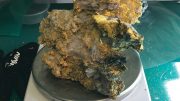VANCOUVER — Welcome to a new feature at The Northern Miner where we have some fun with raw data sets relating to mining, mineral exploration, and commodity markets.
To begin we’ll be looking at equity financing.
It’s no secret that capital markets have been challenging over the past few years due to low commodity prices and volatile macro-economic conditions, but what do the numbers actually look like?
For our experiment we’ve drawn from equity finance data for mining stocks on the S&P/TSX Composite Index and S&P/TSX Venture Composite Index and set up some further limiting parameters: we’ll only look at companies raising money to explore and develop properties in Canada; eliminate financings below $500,000; and use an 18-month window from January 2015 through April 25, 2016.
Starting big, our first graphic is simple: gross proceeds raised via equity by junior miners and developers over the past 18 months:

We can see by the trend line that financings have been heading in a positive direction.
In total we have 115 equity issuances among 74 companies that generated gross proceeds of $1.09 billion.
Now let’s pose the question: Where in Canada is the money going?

Here, we’ve broken down the equity placements by province and territory along the left axis, which are the bar charts. We’ve calculated the number of equity placements along the right axis via the black line.
First thing that stands out is that B.C., Nunavut, and Saskatchewan are dominant. In fact, these three regions account for nearly 73% of total capital raised on equity markets for Canadian projects. But we’re on the lookout for outliers, since only a few bigger development-stage companies might be skewing the average, and indeed that turns out to be the case:

Two companies really stand out on our pie chart: Pretium Resources (TSX: PVG; NYSE: PVG) has raised nearly $300 million during our sample period to fully fund development of its US$747-million Brucejack underground gold mine in northwestern B.C. Meanwhile, TMAC Resources (TSX: TMR) raised $164 million to develop its flagship Hope Bay gold project in Nunavut.

Building the Brucejack gold mine, 950 km northwest of Vancouver, British Columbia. Credit: Pretium Resources.
That tells us where new Canadian gold production will be coming online in the short-term since both mines are scheduled to begin commercial production in 2017.
Next, let’s take the developers out and look purely at exploration because that could tell us where the drills will be turning, and what jurisdictions are attracting investment for earlier-stage projects.
And so, we’ll also exclude Trevali Mining‘s (TSX: TV; US-OTC: TREVF) $30 million raise in New Brunswick, with the money earmarked for ramp-up at its Caribou polymetallic mine and mill in the Bathurst Mining camp.
For good measure we’ll also take out Western Potash (TSX: WPX; US-OTC) since it’s approaching construction at its Milestone project, and received a bulk, $80-million equity investment from China’s Beijing Tairui Innovation Capital. Plus we’ll scratch off capital raised for Rubicon Minerals‘ (TSX: RMX; US-OTC: RBYCF) ill-fated Phoenix gold mine development in Red Lake, Ontario.
Now let’s map this to visualize exploration investments geographically:

Hover over the map and you can see the amount of capital raised in each province over that period, while the number values represent the quantity of financings responsible for a provincial gross proceed.
Interestingly, when we take Pretium out, B.C. really falls back into the pack, and it is now only slightly ahead of Quebec.
Saskatchewan is still a major outlier, but referring to our pie chart we know that’s due to two major uranium investments: NexGen Energy (TSXV: NXE; US-OTC: NXGEF) and its Arrow discovery; and Fission Uranium (TSX: FCU; US-OTC: FCUUF) and its Patterson Lake South (PLS) project. The two companies raised in excess of $150 million over the past 18 months.

NexGen Energy’s exploration camp at the Arrow uranium discovery in Saskatchewan, as seen in mid-2015. Credit: NexGen Energy.
We also know that nearly all the capital raised for projects in the Northwest Territories is attributable to $52-million in financings completed by Kennady Diamonds (TSXV: KDI; US-OTC: KDIAF) for bulk sampling and exploration at its Kennady North project.
So let’s take NexGen, Fission, and Kennady out of the equation:

Now we’re back to our original chart, but we’ve eliminated some of the outliers in terms of gross proceeds raised, and we have a better idea of what’s going on among the majority of companies raising capital on the TSX and TSX Venture Exchange.
In the end we limited the data set by 8 companies (or around 11%), but we saw gross proceeds drop by $800 million to $282 million.
Overall things look to be improving, however, as both gross proceeds and number of equity financings have increased year-on-year to start 2016.
Getting back to our map, we can call it the “exploration edition” since what we’re left with predominantly earlier-stage or “pre-development” project financing at this point. There’s definitely still permit and scoping dollars on here, but we’ve probably eliminated outright earthworks or construction, as well as the big-money discoveries generating an abnormal amount of capital:

Not too surprisingly B.C., Quebec and Ontario remain the top three jurisdictions. Over our time period Ontario and Quebec have been, by far, the preferred destinations for investment capital likely aimed at exploration, as the two provinces account for nearly 50% of the gross proceeds. The numbers align with what we know about flow-through structure, socio-political confidence and mineral endowments.

Glancing at the data plotted over time, however, we can also see that B.C.’s been making a bit of a comeback since around September 2015. Ontario and Quebec have also remained consistently attractive.
Finally, let’s break this down by commodity and see if any specific one is having an especially good 18-months:

So yes, gold is definitely on a roll, and that’s not surprising given the price movement over the past six months. We can likely infer that’s also helping out the Ontario and Quebec gold camps with the exploration investment, and the same is most likely true for B.C.’s recent string of investment activity.
Interestingly, there’s been some buzz around lithium-ion battery demand, and we can see both graphite and lithium have received some capital over our time period as well.
The raw data in this article was sourced from Mining Intelligence which provides a premier tool for evaluating global mining opportunities. It provides company and project information which is merged with financial data to bring unique insight into areas such as company evaluations, M&A, due diligence, competitor intelligence and project pipeline evaluation. Contact Intelligence Mine to learn more.






Be the first to comment on "TNM Data Miner: Digging into the data on equity financings in Canada"